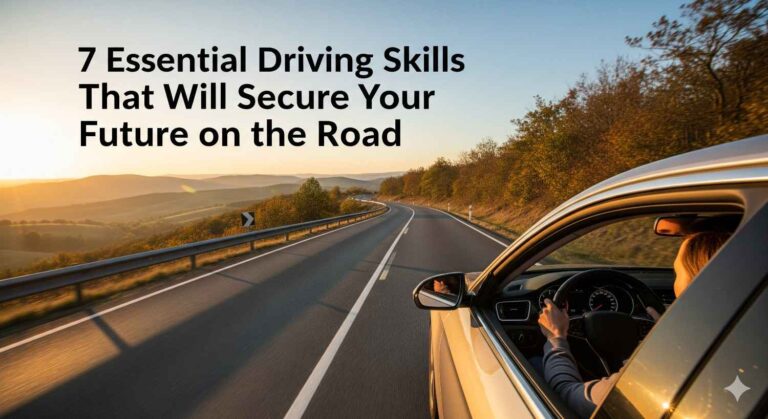The decisions you make behind the wheel today directly impact your safety, financial well-being, and driving privileges for years to come. Whether you’re a new driver or looking to sharpen existing skills, developing smart driving habits is one of the most valuable investments you can make in your future. From avoiding costly accidents to maintaining a clean driving record that keeps insurance premiums low, the benefits of becoming a skilled, defensive driver extend far beyond simply getting from point A to point B.
Master Defensive Driving Techniques
Defensive driving forms the foundation of safe, smart driving practices. This approach involves anticipating potential hazards and maintaining constant awareness of your surroundings. Studies show that defensive drivers are 50% less likely to be involved in traffic accidents compared to reactive drivers.
The key principles include maintaining a safe following distance of at least three seconds, scanning the road ahead for potential dangers, and always having an escape route planned. Professional driving instructors emphasize that defensive driving isn’t just about following rules—it’s about developing the mindset that every other driver might make an unpredictable move.
Develop Weather-Adaptive Driving Skills
Weather conditions account for nearly 22% of all vehicle crashes annually, according to the Federal Highway Administration. Learning to adjust your driving style for different weather conditions is crucial for long-term safety. In wet conditions, reduce your speed by 25% and increase following distance to at least six seconds.
During winter driving, practice controlled braking and steering techniques in a safe environment before facing challenging conditions. Smart drivers also understand when to avoid driving altogether—sometimes the best decision is waiting for conditions to improve rather than risking an accident that could affect your driving record and insurance rates for years.

Perfect Your Parking and Maneuvering Abilities
Strong parking and maneuvering skills do more than prevent embarrassing moments—they protect you from costly fender-benders and property damage claims. Insurance companies report that parking lot accidents account for over 20% of all auto insurance claims. Practice parallel parking, backing into spaces, and navigating tight spaces until these maneuvers become second nature.
Many driver’s ed classes in Utah and other states now incorporate advanced maneuvering techniques using modern vehicle safety features like backup cameras and parking sensors, helping new drivers adapt to current automotive technology while building fundamental skills.
Build Hazard Recognition and Response Skills
The ability to quickly identify and respond to road hazards separates good drivers from great ones. Research indicates that drivers who actively practice hazard recognition techniques experience 40% fewer close calls and near-miss situations.
Train yourself to constantly scan for pedestrians, cyclists, merging vehicles, and road obstacles. Develop the habit of checking mirrors every 5-8 seconds and being aware of vehicles in your blind spots. Professional driving instructors teach students to look 12-15 seconds ahead while driving, allowing ample time to react to developing situations rather than being forced into emergency maneuvers.
Master Proper Following Distance and Speed Management
Tailgating and inappropriate speed are leading causes of preventable accidents, often resulting in at-fault determinations that can increase insurance premiums by 20-40% for three to five years. The three-second rule provides a minimum safe following distance in ideal conditions, but smart drivers adjust this based on weather, traffic density, and road conditions. Speed management goes beyond simply following posted limits—it involves choosing speeds appropriate for current conditions. During heavy traffic or construction zones, driving significantly below the speed limit is often the safest choice, even when other drivers are being more aggressive.
Develop Advanced Communication Skills on the Road
Effective communication while driving involves more than using turn signals—though proper signal usage remains crucial for preventing accidents and traffic violations. Use your vehicle’s lights, horn, and positioning to clearly communicate your intentions to other drivers.
Make eye contact with pedestrians and cyclists when possible to ensure they’ve seen you. Avoid aggressive gestures or behaviors that can escalate road rage situations. Statistics show that courteous, communicative drivers are involved in fewer conflicts and accidents, contributing to cleaner driving records and lower insurance costs over time.
Cultivate Vehicle Maintenance Awareness
Understanding basic vehicle maintenance and recognizing warning signs of mechanical issues is essential for preventing dangerous situations and costly breakdowns. Regular tire pressure checks, oil changes, and brake inspections help ensure your vehicle responds predictably in emergencies.
Learn to recognize signs of brake problems, steering issues, or tire wear that could compromise safety. Drivers who maintain their vehicles properly experience fewer unexpected mechanical failures that could lead to accidents or leave them stranded in dangerous situations.

Investing time in developing these essential driving skills pays dividends throughout your driving career. The habits you build today determine whether you’ll enjoy decades of safe, affordable driving or face the consequences of preventable accidents and violations. Consider enrolling in advanced driving courses or refresher programs to continue developing your skills—your future self will thank you for the investment in safety and financial security.

